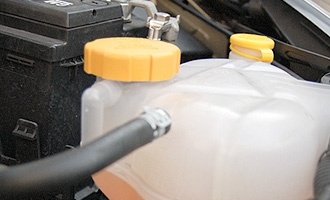| Routine Maintenance | << Back to Education |
Coolant Level
Having your car break down is at best inconvenient, but at worst can be very dangerous.
We have therefore created this section to help you keep your car in road worthy condition and reduce the chances of vehicle malfunction.
To find information about how to act if you do breakdown, click here

Coolant Level
| Coolant level is checked by way of the surge tank, often mounted in close proximity to the sealed radiator cap. | |
| To check the fluid, the vehicle must be on level ground, and preferably, it should be “cold.” In most cases, the surge tank is transparent and will be marked with the letters “FULL COLD.” You can physically see the level in the tank. | |
| If you need to add coolant, first check the specifications in your owner's manual. Do not add water alone as most vehicles today require some form of coolant blend. | |
| If the car is older, and is not equipped with a surge tank, wait until the engine has cooled before opening the radiator cap. | |
| Turn the cap slowly to the left until it reaches a “stop.” Don’t press down on the cap. Wait a minute or so before proceeding. If you hear a hissing sound, pressure is being relieved. | |
| Once the hissing sound stops, press down on the cap and continue to turn to the left. Fill the radiator to the base of the filler neck then start the engine | |
| With the engine running, add coolant to the radiator until it reaches the bottom of the filler neck, then reinstall the radiator cap. | |
| Be careful with coolant, as most blends contain ethylene glycol, which will burn if the spilled on very hot external engine components (for example, exhaust manifolds). |
© ![]() has compiled this information to be used for educational purposes only
has compiled this information to be used for educational purposes only








